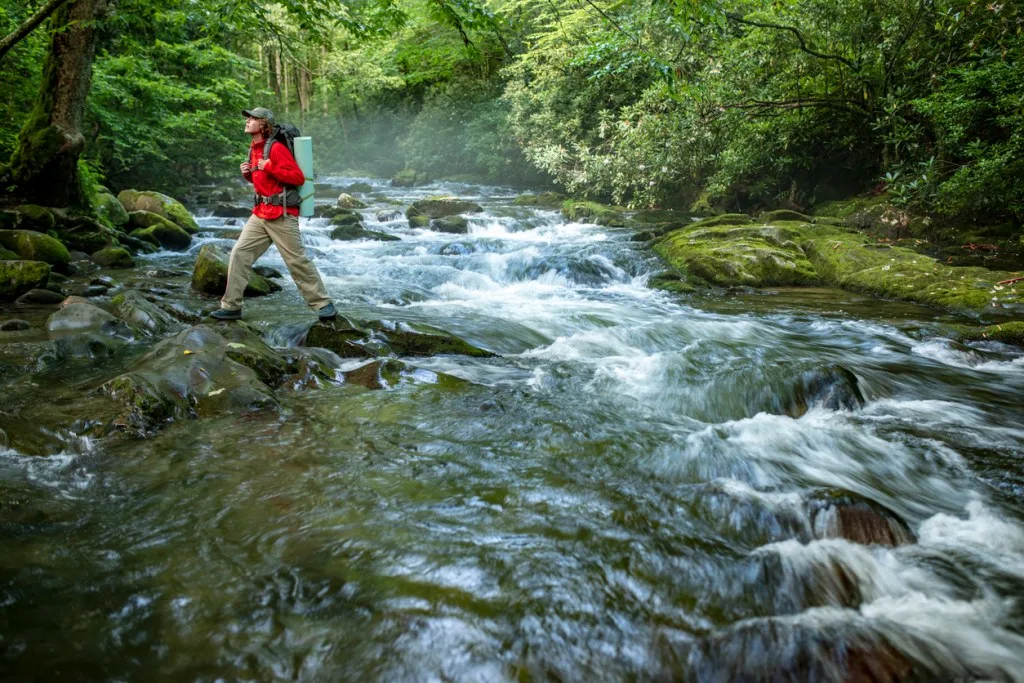Great Smoky Mountains National Park is host to incredible campgrounds with various options for RVers, backpackers, and horse campers.
Whether you want to camp by a river, a mountain, or deep in a valley, the Smoky Mountains campgrounds have it all.
But what time of year can you go? Are any of the campgrounds available year-round?
Let’s take a look!
Smoky Mountains Campgrounds to Re-Open Soon
Great Smoky Mountains National Park is one of the most popular parks in the US. Spanning the border between Tennessee and North Carolina, the park marks over 520,000 acres of natural beauty. Once almost decimated by logging, the creation of the park in 1934 saved the land from complete deforestation.
The name Smoky comes from the mist that hovers gently over the peaks and valleys.
A mixture of moisture and dense vegetation causes the bluish smoke. Great Smokey Mountains is the most biodiverse park within the National Park System. Most visitors need several days to explore. Or even several visits!

It’s a good thing there are so many campground options!
There’s an abundance of camping options in Smoky National Park. The dozen or so traditional campgrounds host over 800 sites. You can also reserve more than 100 backcountry campgrounds. These are designated sites or shelters accessible only by foot.
Given the variances in elevation within the park, most campgrounds close during the winter season. Paving work and weather conditions can also cause road closures. The park maintains an excellent Twitter account to keep track of closures within the Smokies.
On rare occasions, a bear sighting might cause a campground to close. But generally speaking, if you plan your visit between April and October, you are good to go.
Two Smoky Mountains campgrounds, Cades Cove and Smokemont, are open year-round.
PRO TIP: Hey there haters – here are 5 reasons to avoid the Smoky Mountains.
About the Frontcountry Campgrounds
The most popular spots in the Smoky Mountains campgrounds are frontcountry grounds. Frontcountry camping refers to staying at an established, road-accessible site.
These sites have general amenities that many campers are accustomed to, such as a parking spot and potable water. Other common amenities include restrooms, picnic tables, dump stations, and fire rings.
There are ten frontcountry campgrounds in the Great Smoky Mountains National Park. Overnight prices range from $17 to $27. Tent pads are available at some campgrounds. You’ll want to check availability well before your trip. As of March 2022
One popular frontcountry option is Smokemont Campground in Cherokee, North Carolina. Beautiful mountain ranges and rolling streams surround it. Campers love the access to trails, fishing, and bird watching. Given that this is bear country, campers must seal and store all food and cooking equipment in a vehicle or non-pliable material.
As Smokemont campground is open year-round, it can get a little crowded. Cell service can be spotty, and electricity is only available for medical use via 5-amp outlets. Still, this is a favorite amongst the RV community. Try to park in Loop F for a little more space.

Cataloochee is another popular Smoky Mountains campground. Located in a valley in Waynesville, North Carolina, Cataloochee Campground is quiet and pristine. Elk are common in the area. This dry camping spot has utility sinks, food storage lockers, and grills.
Be prepared for poor cell service and the sharp, windy road in. Although big rigs might not be a good fit, RVers with Class Cs or smaller give it five stars.
About the Smoky Mountains Group Campgrounds
Smoky Mountains Group campgrounds are places where parties of seven to thirty people can camp. Big Creek, Cades Cove, Cataloochee, Cosby, Deep Creek, Elkmont, and Smokemont have group sites.
The campgrounds have varying max capacities and fees. However, the nightly fees for parties of 20 average $2.50 per person. That’s a great deal!
Group camping is an excellent opportunity for events like family reunions, church gatherings, and friendship getaways. The sites are structured for tent use only. Each location provides picnic tables, restrooms, drinking water, and a fire pit. Elkmont, Smokemont, and Cataloochee are popular group destinations.
About the National Park’s Horse Camps
There are five horse camps in the Smoky Mountains. Each offers hitch racks for horses and is accessible by vehicle. Two camps are within Cataloochee and Big Creek. While the other three are at Anthony Creek, Round Bottom, and Tow String.
Each site offers plenty of trails to ride and a quiet spot to camp for the night. Fees range from $23-$29 per night.
Horse camps are considered backcountry campgrounds and require reservations and a permit.
These are tent-only sites with varying bare-bones amenities. Big Creek is the only horse camp with flush toilets and potable water. It’s also located near the Appalachian trail and has ideal horseback riding terrain.
If you’re looking to camp deep in the woods, try Anthony Creek Horse Camp. It’s near the Cades Cove picnic area in Townsend, Tennessee. You can climb the challenging yet rewarding Bote Mountain Trail.
Store food in your vehicle’s trunk at all horse campgrounds.

About the Smoky Mountains Picnic Areas
Picnic areas for day trips exist both within and outside Smoky Mountains Campgrounds. There are eleven designated picnic spots in the park.
Although many people like to wing it and toss provisions in the car and go, there are advantages to planning your picnic destination. You can only cook in a designated picnic area. One may be next to a creek, while another has a grill next to a breathtaking view. Know before you go!
Pavilions are available at Collins Creek, Cosby, Deep Creek, Greenbrier, Metcalf Bottoms, and Twin Creeks. These are large, covered areas with multiple tables that require a reservation.
Auto Touring in the Smoky Mountains
Auto touring is what city slickers call exploring the great outdoors. You get in your car, go to the national park, and drive around. There are almost 400 miles to be traveled within Smoky National Park.
Some popular destinations include Clingmans Dome, Roaring Fork, and Roaring Fork. Booklet guides are available at park visitor centers.
Be sure to check for road closures before you go. Parts of the Foothills Parkway will be closed through mid-2023 for pavement repairs. The Cades Cove Loop will be closed to vehicles every Wednesday from May to the end of September.
This may make some drives grouchy. But it’s a boon for walkers and bicyclists alike. According to park officials, visitors are hoping for additional vehicle-free access opportunities.
Abundant Camping in the Smoky Mountains
Great Smoky Mountains National Park offers an abundance of camping opportunities and recreational getaways. Although a couple of campgrounds provide year-round access, your best bet is to plan for a spring or fall adventure.
If a campfire is in your plans, be sure to only use wood from within the park. Bringing wood in from anywhere else threatens the trees due to the invasive insect species inside the firewood.
What’s your experience with Smoky Mountains campgrounds? Have you ever been to one?
Discover the Best Free Camping Across the USA
To be honest with you, we hate paying for camping. There are so many free campsites in America (with complete privacy).
You should give it a try!
As a matter of fact, these free campsites are yours. Every time you pay federal taxes, you’re contributing to these lands.
Become a FREE CAMPING INSIDER and join the 100,000 campers who love to score the best site!
We’ll send you the 50 Best Free Campsites in the USA (one per state). Access the list by submitting your email below: